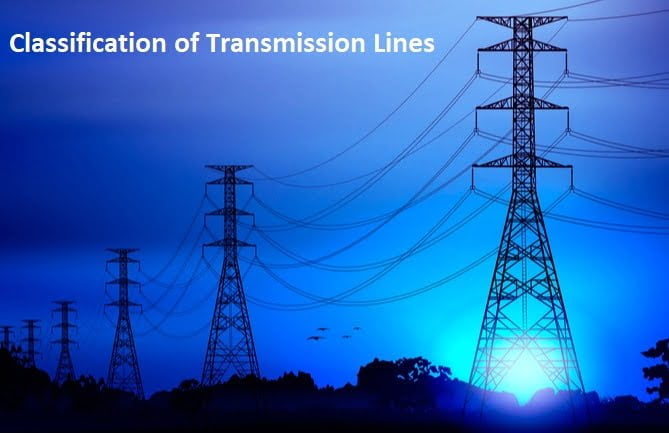Classification of Transmission Lines
Transmission lines play a pivotal role in the efficient and reliable distribution of electrical power over long distances. These lines are the arteries of modern electrical grids, facilitating the seamless transfer of electricity from power generation sources to end consumers. Classification of transmission lines is a crucial aspect of understanding their diverse characteristics and applications within the power infrastructure. This article explores the classification of transmission lines based on various criteria and sheds light on their significance in the realm of electrical engineering.
Introduction to Transmission Lines
Transmission lines are the conductive pathways that connect power generation facilities, such as power plants or renewable energy sources, to substations, which then distribute electricity to residential, commercial, and industrial users. These lines are responsible for carrying high-voltage electrical currents over extensive distances while minimizing losses and maintaining grid stability.

Classification Criteria
Transmission lines can be classified based on several key criteria:
1. Voltage Level:
Voltage level is a primary criterion for classifying transmission lines. They are typically categorized as:
- High-Voltage Transmission Lines: These lines operate at voltages ranging from 69 kV (kilovolts) to 765 kV and are used for transmitting electricity over long distances.
- Extra-High Voltage Transmission Lines: Operating at voltages between 765 kV and 1100 kV, these lines are employed to transmit electricity across regions or countries.
- Ultra-High Voltage Transmission Lines: These lines operate at voltages exceeding 1100 kV and are used for exceptionally long-distance power transmission, often spanning national borders.
2. Length and Application:
Transmission lines can also be classified based on their length and specific application:
- Long Transmission Lines: These lines extend over hundreds of kilometers and are designed to transmit power between different regions or even countries.
- Short Transmission Lines: Spanning shorter distances, these lines connect local power generation sources to distribution substations.
- Submarine Transmission Lines: These specialized lines are laid beneath water bodies to connect offshore power generation sources, such as wind farms, to onshore grids.
3. Conductor Configuration:
The configuration of conductors within a transmission line is another classification criterion:
- Single-Circuit Lines: These lines consist of a single set of conductors and are commonly used in less populated areas or for shorter distances.
- Double-Circuit Lines: These lines feature two sets of conductors on the same tower structures, allowing for higher power transmission capability and redundancy.
- Multi-Circuit Lines: Utilizing three or more sets of conductors, these lines further enhance the capacity and reliability of power transmission.
4. Operating Voltage:
Based on the operating voltage, transmission lines can be classified as:
- AC (Alternating Current) Lines: The most common type of transmission lines, they transmit power as alternating current and are preferred for short to medium distances.
- DC (Direct Current) Lines: These lines transmit power as direct current and are suitable for very long-distance transmission, interconnecting asynchronous grids, and enhancing grid stability.
5. Environmental Considerations:
Transmission lines may also be classified based on their environmental impact:
- Overhead Transmission Lines: These lines are installed above ground on towers, making them more visible but easier to access for maintenance.
- Underground Transmission Lines: These lines are buried underground, reducing visual impact but increasing installation and maintenance complexity.
Significance of Classification
The classification of transmission lines serves several important purposes:
- Design and Planning: Different types of transmission lines require distinct design considerations and engineering approaches. Proper classification aids in efficient system planning and ensures optimal performance.
- Load Management: Understanding the classification helps grid operators manage loads, balance power generation, and maintain stable transmission across varying distances.
- Reliability and Redundancy: The classification guides the integration of redundancy mechanisms, such as double-circuit lines, which enhance the grid’s reliability by providing backup routes for power transmission.
- Environmental Impact: By categorizing transmission lines based on their environmental impact, stakeholders can make informed decisions that balance the need for power transmission with environmental preservation.
- Investment and Cost Estimation: Accurate classification aids in estimating costs for constructing, maintaining, and upgrading transmission lines, assisting in budget allocation and investment planning.
FAQs
What is the classification of transmission lines?
Transmission lines are classified based on factors such as voltage level, conductor configuration, length, and environmental impact.
How are transmission lines classified based on voltage level?
Transmission lines can be categorized into high-voltage, extra-high voltage, and ultra-high voltage lines, depending on the operating voltage.
What are the different types of conductor configurations in transmission lines?
Conductor configurations include single-circuit lines, double-circuit lines, and multi-circuit lines, each with varying power transmission capacities.
What is the difference between AC and DC transmission lines?
AC transmission lines carry alternating current, while DC transmission lines transmit direct current, offering distinct advantages for different distances and applications.
How do submarine transmission lines work?
Submarine transmission lines are laid underwater to connect offshore power sources like wind farms to onshore grids, enabling efficient power transfer.
Why is the classification of transmission lines important for grid stability and reliability?
Proper classification helps plan and design grids, manage loads, ensure redundancy, and assess environmental impact, ensuring a stable and reliable power distribution network.
Conclusion
Transmission lines are the backbone of modern power systems, enabling the efficient and reliable transmission of electrical energy over vast distances. The classification of transmission lines based on criteria such as voltage level, length, conductor configuration, operating voltage, and environmental considerations is essential for effective design, planning, and management of power grids. As technological advancements continue to shape the energy landscape, a thorough understanding of transmission line classification remains pivotal in ensuring the stability, sustainability, and resilience of global electrical infrastructure.
 Electrical Engineering World Wiring a Brighter Tomorrow!
Electrical Engineering World Wiring a Brighter Tomorrow!